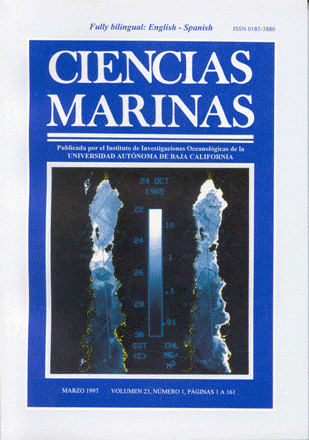On the structure of a deep scattering layer on the coastal shelf off bahía magdalena, baja california, mexico
Main Article Content
Abstract
Se describe la composición específica y estructura de una capa de dispersión profunda encontrada en el suroeste de la península de Baja California, México. Los muestreos se realizaron mediante arrastres con red Isaacs-Kidd, red Bongo y registros hidroacústicos. Los resultados demuestran la dominancia de tres especies: un eufáusido, Euphausia eximia Hansen 1911; un decápodo de la familia Galatheidae. Pleuroncodes planipes (Stimpson. 1860); y un pez de la familia Photichthyidae, Vinciguerria lucetia (Garman, 1899). Los ecos acústicos de la capa de dispersión profunda fueron separados de acuerdo con la fuerza de blanco usando una ecosonda SIMRAD EY-200, con una frecucncia de 200 kHz. y un programa denominado Hydro Acoustic Data Acquisition System (HADAS). Los eufáudidos fueron asociados con un intervalo de fuerza de blancos entre -56 y -62 dB, las langostillas entre -51 y -55 dB,.y los peces entre -32 y -50 dB. Los resultados indican que los organismos presentaron una distribución no azarosa dentro de Ia capa de dispersión profunda, esto es,.tuvieron una estructura interna tanto en sentido horizontal como vertical.
The structure of an intense deep scattering layer off the southwest coast of Baja California, Mexico, is described using Isaacs-Kidd net trawl samples, Bongo samples and hydroacoustic records. Results demonstrate the dominance of three organisms: an euphausiid, Euphausia eximia Hansen 1911; a decapad of the family Galatheidae, Pleuroncodes planipes (Stimpson, 1860); and a fish of the family Photichthyidae, Vinciguerria lucetia (Garman, 1899). Using a SIMRAD EY-200 echosounder, with a working frequency of 200 kHz, and a Hydro Acoustic Data Acquisition System (HADAS), echoes were separated according to their target strength. Euphausiids were associated with the -56 to -62 dB target strength group, the red crabs with the -51 to -55 dB group, and fishes with the -32 to -50 dB group. Results indicate that organisms within the layer were not randomly distributed, but that they have an internal] structure both in a horizontal and vertical dimension.
The structure of an intense deep scattering layer off the southwest coast of Baja California, Mexico, is described using Isaacs-Kidd net trawl samples, Bongo samples and hydroacoustic records. Results demonstrate the dominance of three organisms: an euphausiid, Euphausia eximia Hansen 1911; a decapad of the family Galatheidae, Pleuroncodes planipes (Stimpson, 1860); and a fish of the family Photichthyidae, Vinciguerria lucetia (Garman, 1899). Using a SIMRAD EY-200 echosounder, with a working frequency of 200 kHz, and a Hydro Acoustic Data Acquisition System (HADAS), echoes were separated according to their target strength. Euphausiids were associated with the -56 to -62 dB target strength group, the red crabs with the -51 to -55 dB group, and fishes with the -32 to -50 dB group. Results indicate that organisms within the layer were not randomly distributed, but that they have an internal] structure both in a horizontal and vertical dimension.
Downloads
Download data is not yet available.
Article Details
How to Cite
Robinson, C., Gómez, J., & Arenas, V. (1997). On the structure of a deep scattering layer on the coastal shelf off bahía magdalena, baja california, mexico. Ciencias Marinas, 23(1), 141–154. https://doi.org/10.7773/cm.v23i1.769
Issue
Section
Research Article
This is an open access article distributed under a Creative Commons Attribution 4.0 License, which allows you to share and adapt the work, as long as you give appropriate credit to the original author(s) and the source, provide a link to the Creative Commons license, and indicate if changes were made. Figures, tables and other elements in the article are included in the article’s CC BY 4.0 license, unless otherwise indicated. The journal title is protected by copyrights and not subject to this license. Full license deed can be viewed here.

